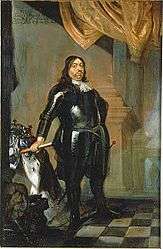Treaty of Königsberg (1656)
|
| |
| Type | Legal status of the Duchy of Prussia |
|---|---|
| Signed | 17 January 1656 |
| Location | Königsberg castle (now Kaliningrad) |
| Signatories |
Charles X Gustav of Sweden Frederick William I of Brandenburg |
| Parties |
Swedish Empire House of Hohenzollern |
| Language | Latin |
The Treaty of Königsberg was concluded on 7 January (O.S.) / 17 January (N.S.) 1656 during the Second Northern War.[1] Frederick William I, the "Great Elector" of Brandenburg and duke of Prussia, was forced to join the Swedish camp and became a Swedish vassal for the Duchy of Prussia and Ermland (Ermeland, Warmia).[2] In a second treaty, negotiated on 24 February 1656 in Königsberg (Królewiec), Frederick William I concluded a defensive alliance with France.[3]
Background
In 1655, the rapid progress of the Swedish campaign in Poland-Lithuania made Brandenburgian elector Frederick William I worried about his Duchy of Prussia,[4] which he held as a Polish fief.[2] Frederick William I, who maintained an army of 14,000 men in Brandenburg,[1] marched his army to Prussia[4] and in the Treaty of Rinsk of 12 November concluded a defensive alliance with the Royal Prussian nobility, who maintained an army consisting of 600 troops raised by the Prussian estates and a levy of 3,000 to 4,000 men.[1] In addition, 3,600 troops of the regular army and mercenaries were stationed in Royal Prussia.[1]
Charles X Gustav had meanwhile conquered nearly all of Poland and exiled the Polish king John II Casimir Vasa.[1] From occupied Cracow, he turned northwards in October[5] to subdue Royal Prussia, where he intended to establish a Swedish province.[4] By December, all of Royal Prussia was occupied by Sweden[4] except for Danzig (Gdańsk), which resisted throughout the war, and Marienburg (Malbork), which only fell in March 1656.[1] Thorn (Toruń) and Elbing (Elbląg) had not participated in the alliance of Rinsk and surrendered to Sweden already in November.[1] Now Charles X Gustav turned eastwards and marched his troops into Ducal Prussia, following the withdrawing army of Frederick William I.[4] While field marshal Count Georg Friedrich von Waldeck urged the "Great Elector" to confront the Swedish forces, the latter chose not to fight and accept the Swedish terms in January.[6]
Treaty between Brandenburg-Prussia and Sweden
Frederick William I took the Duchy of Prussia as a fief from Charles X Gustav, and had to provide him with troops.[2] Without Swedish permission, the Electorate of Brandenburg would not maintain a navy in the Baltic Sea.[2] In return, Frederick William I received Ermland.[2]
In article XVII, the Lutheran Swedish king further obliged the Calvinist elector to grant religious freedom to the Lutherans in Prussia.[7]
Treaty between Brandenburg-Prussia and France
The Franco-Prussian treaty included a defensive alliance between the parties.[3] Drafted on 24 February, it was ratified on 12 April by Louis in Paris and on 24 October by Frederick William in Königsberg.[3]
Consequences
The treaty of Königsberg was followed by the Treaty of Marienburg on 25 June, when the tide of the war had turned against Sweden and Brandenburg-Prussia advanced to the position of a Swedish ally.[8]
Still a vassal of Charles X Gustav for Prussia,[2] Frederick William I entered the war and the combined Swedish-Brandenburgian forces defeated the Polish army in the Battle of Warsaw in July.[9] This made the Polish king John II Casimir Vasa, from whom Frederick William I had to take Prussia as a fief prior to Königsberg, say that once the Tartars had the Swedes for breakfeast, he would arrest the elector "where neither sun nor moon will shine".[2] In August, John II Casimir had Wincenty Korwin Gosiewski invade Prussia to "punish Frederick William for his treachery".[10] Thirteen towns and 250 villages were burned until Gosiewski was expelled in October, and the campaign was terrifying enough to persist in local folklore until the 20th century.[11]
Hard-pressed himself by several countries entering the war against him, Charles X Gustav in January 1656 agreed with Frederick William I on the Treaty of Labiau, which altered the terms of Königsberg in a way that the Hohenzollern electors were freed of Swedish vassalage for the Prussian duchy at the cost of Ermland and a more active participation in the war.[12] In the subsequent treaties of Wehlau and Bromberg, John II Casimir confirmed Frederick William I's sovereignty in Prussia after the latter abandoned Sweden in the war.[13]
See also
Sources
References
- 1 2 3 4 5 6 7 Frost (2000), p. 171
- 1 2 3 4 5 6 7 Press (1991), p. 402
- 1 2 3 von Moerner (1965), p. 201
- 1 2 3 4 5 Press (1991), p. 401
- ↑ Frost (2000), p. 172
- ↑ Press (1991), pp. 401-402
- ↑ Evans (1997), p. 54
- ↑ Frost (2000), p. 173
- ↑ Frost (2000), pp. 173-174
- ↑ Frost (2000), p. 177
- ↑ Frost (2000), p. 178
- ↑ Press (1991), pp. 402-403
- ↑ Press (1991), p. 403
Bibliography
- Evans, Malcolm (1997). Religious liberty and international law in Europe. Cambridge studies in international and comparative law. 6. Cambridge University Press. ISBN 0-521-55021-1.
- Frost, Robert I (2000). The Northern Wars. War, State and Society in Northeastern Europe 1558-1721. Harlow: Longman. ISBN 978-0-582-06429-4.
- von Moerner, Theodor, ed. (1965). Königlich Geheimes Staatsarchiv. Kurbrandenburgs Staatsverträge von 1601-1700 (in German). de Gruyter.
- Press, Volker (1991). Kriege und Krisen. Deutschland 1600-1715. Neue deutsche Geschichte (in German). 5. Munich: Beck. ISBN 3-406-30817-1.
External links
- Scan of the treaty of Königsberg (Brandenburg-Prussia and Sweden) at ieg-mainz.de (Institut für Europäische Geschichte Mainz), 32 pages
- Scan of the treaty of Königsberg (Brandenburg-Prussia and France) at diplomatie.gouv.fr (French Ministry for Foreign Affairs), 31 pages, pdf


